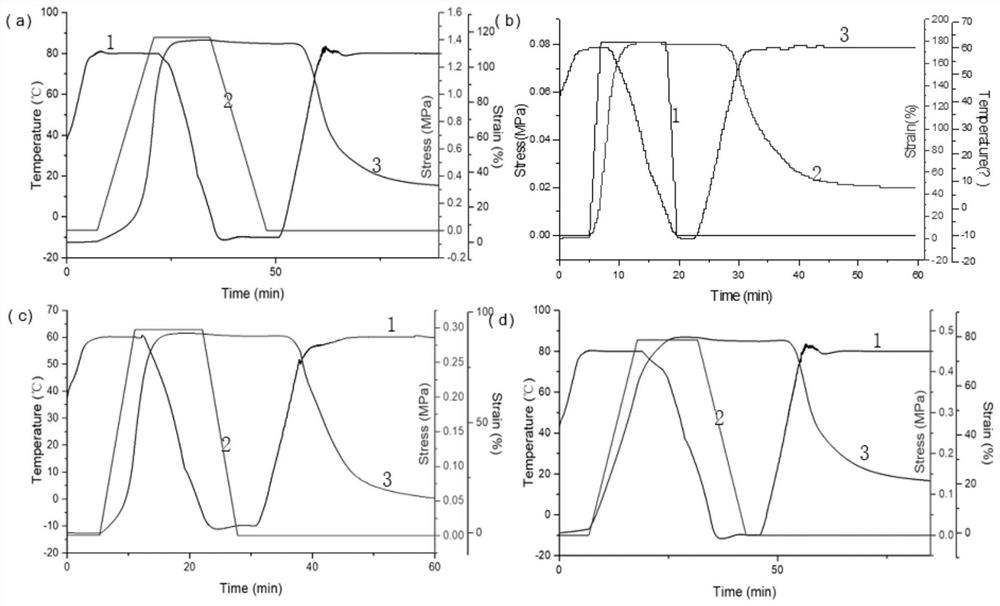Preparation method and application of photo-cured polyurethane with self-healing property and shape memory property
A polyurethane and self-healing technology, applied in polyurea/polyurethane coatings, coatings, etc., can solve the problems of easy aging, short service life of polymer materials, and less research on crystal side chain self-healing, and achieve the effect of repairing cracks
- Summary
- Abstract
- Description
- Claims
- Application Information
AI Technical Summary
Problems solved by technology
Method used
Image
Examples
preparation example Construction
[0032] (1) Preparation of quaternized dihydroxyethylene glycol: get 1.19g (0.01mol) N-methyldiethanolamine (MDEA) and 3.94g (0.01mol) bromodocosane in a three-necked flask, set the temperature At 100°C, the reaction was stirred for 12 hours to obtain quaternized dihydroxyethylene glycol (0.01mol).
[0033] (2) Preparation of polyurethane hard segment: Take 5.13g (0.01mol) of quaternized dihydroxyethylene glycol and 3.36g (0.02mol) of hexamethylene diisocyanate (HDI) into a three-necked flask for mixing, drop 3-4 Drop dibutyltin dilaurate (DBTDL) and react at 60°C for 2 hours. When the NCO value reaches the theoretical value, the reaction is stopped to obtain a polyurethane hard segment component, which is recorded as product 1 (0.01mol).
[0034] (3) Preparation of polyurethane soft segment: Take 2.91g (0.015mol) tetraethylene glycol (TEG) and 1.68g (0.01mol) hexamethylene diisocyanate (HDI) into a three-necked flask, drop 3-4 drops of dilaurel Dibutyltin dibutyltin (DBTDL) w...
Embodiment 1
[0039] (4) Preparation of UV-cured polyurethane: Take 7.64g (0.009mol) of product 1 and 0.46g (0.001mol) of product 2 into a three-necked flask, add 3-4 drops of dibutyltin dilaurate (DBTDL), at 60°C After reacting for 2 hours, 2.21 g (0.017 mol) of hydroxyethyl methacrylate (HEMA) was added, and the reaction was continued for 2 hours to obtain a polyurethane emulsion.
[0040] (5) Curing of polyurethane: Take 5g of polyurethane emulsion, add 0.25g of 1173 photoinitiator, stir and coat on the sample plate, put it on a UV curing machine to cure for 30-60s, and then get UV cured with self-healing properties and shape memory Resistant polyurethane PU1.
Embodiment 2
[0042] (4) Preparation of UV-cured polyurethane: Take 6.79g (0.008mol) of product 1 and 0.92g (0.002mol) of product 2 into a three-necked flask, add 3-4 drops of dibutyltin dilaurate (DBTDL), at 60°C After reacting for 2 hours, 1.82 g (0.014 mol) of hydroxyethyl methacrylate (HEMA) was added, and the reaction was continued for 2 hours to obtain a polyurethane emulsion.
[0043] (5) Curing of polyurethane: Take 5g of polyurethane emulsion, add 0.25g of 1173 photoinitiator, stir and coat on the sample plate, put it on a UV curing machine to cure for 30-60s, and then get UV cured with self-healing properties and shape memory Resistant polyurethane PU2.
PUM
| Property | Measurement | Unit |
|---|---|---|
| tensile strength | aaaaa | aaaaa |
| tensile strength | aaaaa | aaaaa |
| tensile strain | aaaaa | aaaaa |
Abstract
Description
Claims
Application Information
 Login to View More
Login to View More - R&D
- Intellectual Property
- Life Sciences
- Materials
- Tech Scout
- Unparalleled Data Quality
- Higher Quality Content
- 60% Fewer Hallucinations
Browse by: Latest US Patents, China's latest patents, Technical Efficacy Thesaurus, Application Domain, Technology Topic, Popular Technical Reports.
© 2025 PatSnap. All rights reserved.Legal|Privacy policy|Modern Slavery Act Transparency Statement|Sitemap|About US| Contact US: help@patsnap.com



